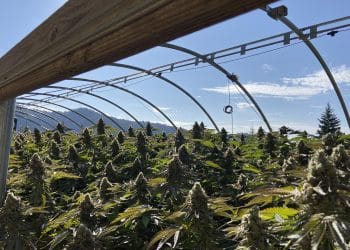Closed-loop refers to a control system where output affects input (and vice versa) in order to modulate system behavior. Open-loop, on the other hand, is a system where output does not affect input. Closed-loop systems utilize automated feedback, and they are a popular, if not necessary, option for cannabis extractors.
To clarify, a household toaster is an open-loop system because we push a button and it heats for a certain arbitrary time and temperature. But an automatic iron is a closed-loop because sensory feedback signals cessation of input (the iron stops heating) when the output (the heat) reaches the desired temperature. Closed-loop systems allow precise control and stability; they are also associated with waste containment and material/energy recovery. [1-3]
In the cannabis space, open-loop systems can be found in DIY operations such as Rick Simpson Oil, where manufacturers manually soak dried flower in ethanol or another solvent for a certain amount of time, then evaporates the solvent. [4, 5] This is a linear process sometimes referred to as ‘open blasting.’
Commercial extractors, on the other hand, almost always use (as required by law) closed-loop systems. [4, 5] Closed-loop extraction systems automate time, pressure, and temperature based on solvent (input) and product (output). [5] Solvent and flower material are literally enclosed and protected from the environment; further, solvent is re-circulated for continued use in the system. It is a circular, enclosed, largely automated process.
For example, the patent for the closed-loop extraction of ExtractionTek describes a proto-typical hydrocarbon system: hydrocarbon containers provide solvent; a recycling pump transports solvent into flower; solvent recycles while extracted oils separate; and thermal jackets control the condensation and evaporation of the solvent. MRX Xtractors offers supercritical CO2 closed-loop extraction with bi-directional pressure and temperature correction, meaning the system automatically adjusts these variables to desired output parameters (i.e., THC, CBD, and terpenes). Precision Extraction supplies equipment compatible with either hydrocarbon or ethanol solvents; systems process raw material within certain timeframes and for a certain number of runs per solvent batch. In all cases, closed-loop extraction involves feedback loops, whether mechanical, electronic, or chemical, to contain and determine product characteristics.
Closed-loop extraction is often colloquially explained as ‘it does not touch air’ (it is closed) and ‘the solvent loops around’ (the loop). Enclosing toxic, flammable solvents is much safer compared to open-air extraction. Nonetheless, autonomous feedback mechanisms and the circular process of material recycling for new input are what define a closed-loop control system. [6-8]
The main downside of closed-loop extraction equipment is cost. Commercial extractors must ensure their equipment is certified by an engineering organization, such as the American Society of Mechanical Engineers. Other relevant approval organizations include the International Fire Code.
In a nutshell, closed-loop extraction is a continuous extraction process that encloses solvent and flower in an automated, efficient loop. It is widely recognized as a safe and commercially-viable alternative to open-air DIY extraction operations.
References
- Weil, Marcel, et al. “Closed-Loop Recycling of Construction and Demolition Waste in Germany in View of Stricter Environmental Threshold Values.” Waste Management & Research, vol. 24, no. 3, June 2006, pp. 197–206, doi:10.1177/0734242X06063686. Journal Impact Factor = 1.33, Times Cited = 36 (ResearchGate)
- Meena, P., et al. “Application of Closed-Loop Oscillating Heat-Pipe with Check Valves (CLOHP/CV) Air-Preheater for Reduced Relative-Humidity in Drying Systems.” Applied Energy, vol. 84, no. 5, May 2007, pp. 553–64, http://10.0.3.248/j.apenergy.2006.09.006. Journal Impact Factor = 7.9, Times Cited = 20 (ResearchGate)
- Bridgens, Ben, et al. “Closing the Loop on E‐waste: A Multidisciplinary Perspective.” Journal of Industrial Ecology, vol. 23, no. 1, Feb. 2019, pp. 169–81, http://10.0.4.87/jiec.12645. Journal Impact Factor = 4.365, Times Cited = 8 (ResearchGate)
- Vogel, Ashley. “Commercial Cultivation of Cannabis.” Cannabis: A Clinician’s Guide,edited by Betty Weidman-St. Louis, Boca Raton, CRC Press, 2018. Google Books
- Al-Zouabi, Ihsan, et al. “Butane Hash Oil and Dabbing: Insights into Use, Amateur Production Techniques, and Potential Harm Mitigation.” Substance Abuse and Rehabilitation, Volume 9, 2018, pp. 91–101., doi:10.2147/sar.s135252.
- Brogi, Etrusca, et al. “Clinical Performance and Safety of Closed-Loop Systems.” Anesthesia & Analgesia, vol. 124, no. 2, 2017, pp. 446–455., doi:10.1213/ane.0000000000001372. Journal Impact Factor = 3.827, Times Cited = 4 (PubMed)
- Bossanyi, E. A. “The Design of Closed Loop Controllers for Wind Turbines.” Wind Energy, vol. 3, no. 3, 2000, p. 149., doi:10.1002/we.34.abs. Journal Impact Factor = 2.938, Times Cited = 319 (ResearchGate)
- Atallah, Raja H., et al. “Continuous Solvent Extraction in a Closed-Loop System.” Analytical Chemistry, vol. 59, no. 24, 1987, pp. 2909–2914., doi:10.1021/ac00151a015. Journal Impact Factor = 6.320, Times Cited = 30 (American Chemical Society)












